Diesel Service Report, January 25, 2023
SF108
Our EMD FP45 is obviously the favorite Run One locomotive at the museum.
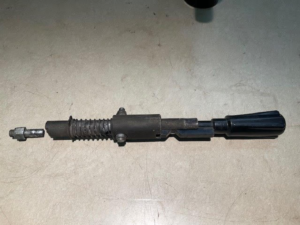
It seems to be booked about once a month or more. Last week after a Run One was completed, the reverser mechanism in the Engineer’s console failed. Something broke internally and the engine could not be moved. Carson King was able to finally get the reverser to operate enough to get the locomotive back to CB7.
John Salvini recalled seeing an identical reverser module in storage at the museum and was able to use a part out of it to fix the broken one in the locomotive.This shows the part that was broken. The small stud on the left side of the reverser had broken off. John and Richard Berk quickly repaired the reverser by installing the spare part that we had on hand.
UP942
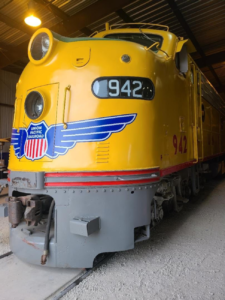 Carson also reported that the hand brake on UP942 had failed. John and Richard were able to release the jammed assembly and get it back together. It appears that a bolt had come loose and dropped out of place.
Carson also reported that the hand brake on UP942 had failed. John and Richard were able to release the jammed assembly and get it back together. It appears that a bolt had come loose and dropped out of place.Three weeks ago the locomotive was wiped down to get all the oil off of it. It was covered with dust and oil. Once it was done, it looked really nice again.
SF560
The trucks are back under the locomotive and operational. But the traction motor leads were in very bad shape. John and Richard spent at least five full days repairing the leads and reconnecting them to the motors and getting them clamped back into the support brackets.
But then it was noticed that there were three missing safety hangars for the elliptical springs under the truck. And one spring was missing its concave end support bracket and another spring end wasn’t properly seated in its hangar. Carl has fabricated new safety hangars and the missing and broken concave brackets will be fabricated and installed. This (right) shows the new safety brackets.
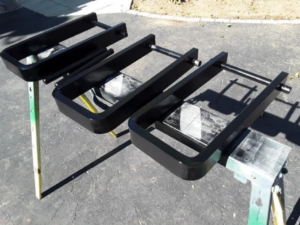
There is something that we don’t fully understand yet. The diesel engine essentially won’t start if the temperature is below about 55 degrees. It blows a lot of white smoke out the stack but the cylinders won’t fire. Richard has used steam to heat the outside of the cylinder liners and was then able to start the engine after that. But an engine shouldn’t have to be up to those temperatures before firing properly. We have installed a 6kW temporary heater and let it run for awhile. It had heated the the radiators up to about 85 degrees but it seems that most of the heat went to the locomotive radiators rather than soaking into the block. We will reverse the flow of hot water to see if that helps. The upper right of the picture below shows our 6kW Tank-less water heater, a circulation pump, and a sediment filter.
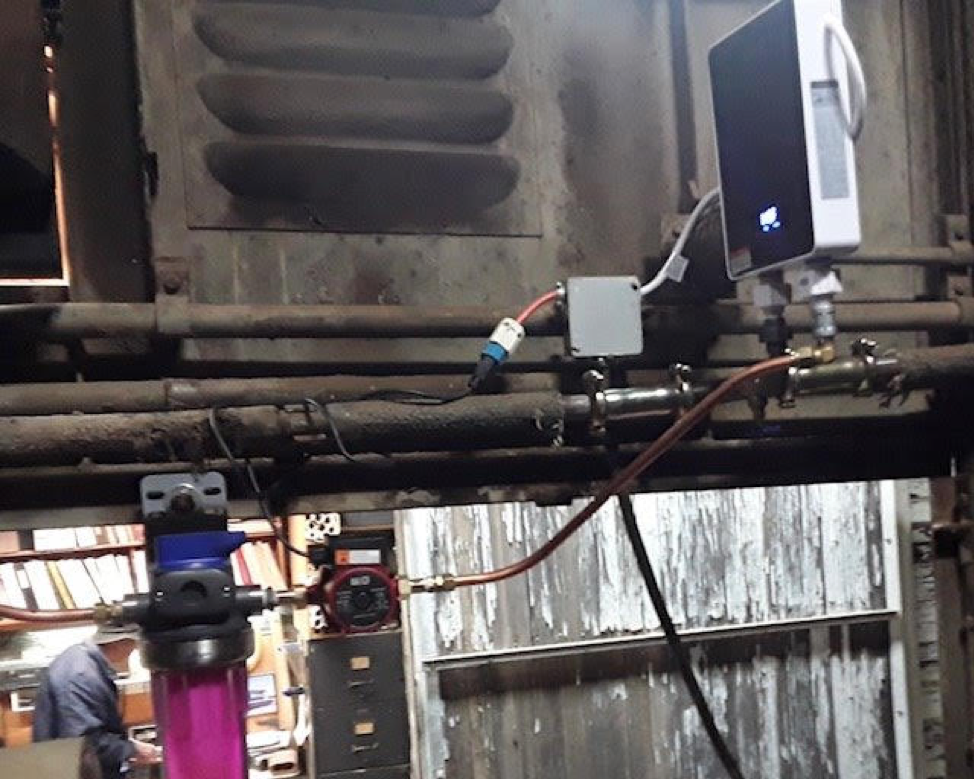 A Diesel engine is actually a pretty simple device. Compressing air causing the air temperature to rise. When the pistons are through their compression cycle, Diesel fuel is atomized and sprayed into that hot air. If the air is hot enough and the fuel is atomized to a fine enough spray, then the fuel will ignite. But if the air isn’t hot enough or the fuel isn’t in a fine enough mist, then the fuel won’t ignite. And as a result, cold weather makes Diesel engines harder to start. We have successfully started this engine in the summer so our best guess is that the problem is temperature related. The white smoke coming out the stack is a pretty good indicator that the injectors are doing their job correctly. Since compression is what causes the air to heat up, that is a critical measurement to take. If cylinder compression is low, the air won’t get hot enough to ignite the fuel. And the main causes of low compression in a 2 cycle engine is worn piston rings and worn cylinder liners.
A Diesel engine is actually a pretty simple device. Compressing air causing the air temperature to rise. When the pistons are through their compression cycle, Diesel fuel is atomized and sprayed into that hot air. If the air is hot enough and the fuel is atomized to a fine enough spray, then the fuel will ignite. But if the air isn’t hot enough or the fuel isn’t in a fine enough mist, then the fuel won’t ignite. And as a result, cold weather makes Diesel engines harder to start. We have successfully started this engine in the summer so our best guess is that the problem is temperature related. The white smoke coming out the stack is a pretty good indicator that the injectors are doing their job correctly. Since compression is what causes the air to heat up, that is a critical measurement to take. If cylinder compression is low, the air won’t get hot enough to ignite the fuel. And the main causes of low compression in a 2 cycle engine is worn piston rings and worn cylinder liners.We know this locomotive was used in a scrap yard for 17 years with no maintenance. That is just as long as it was operated by AT&SF during which time it had very good maintenance. The key now is to take compression readings to see just how bad the problem really is. We know that we can get the engine started but it takes extra special efforts to do it. Installing new piston rings and cylinder liners would cost upwards of $100,000 which is way more than the locomotive is worth. We will know more in the next few months but the guess is, for now at least, that the locomotive will be operational for special occasions but will most probably never be part of the daily use fleet of locomotives at the museum.
– Dave Althaus

